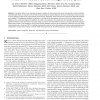Free Online Productivity Tools
i2Speak
i2Symbol
i2OCR
iTex2Img
iWeb2Print
iWeb2Shot
i2Type
iPdf2Split
iPdf2Merge
i2Bopomofo
i2Arabic
i2Style
i2Image
i2PDF
iLatex2Rtf
Sci2ools
PAMI
2010
2010
WLD: A Robust Local Image Descriptor
—Inspired by Weber’s Law, this paper proposes a simple, yet very powerful and robust local descriptor, called the Weber Local Descriptor (WLD). It is based on the fact that human perception of a pattern depends not only on the change of a stimulus (such as sound, lighting) but also on the original intensity of the stimulus. Specifically, WLD consists of two components: differential excitation and orientation. The differential excitation component is a function of the ratio between two terms: One is the relative intensity differences of a current pixel against its neighbors, the other is the intensity of the current pixel. The orientation component is the gradient orientation of the current pixel. For a given image, we use the two components to construct a concatenated WLD histogram. Experimental results on the Brodatz and KTH-TIPS2-a texture databases show that WLD impressively outperforms the other widely used descriptors (e.g., Gabor and SIFT). In addition, experimental results o...
| Added | 29 Jan 2011 |
| Updated | 29 Jan 2011 |
| Type | Journal |
| Year | 2010 |
| Where | PAMI |
| Authors | Jie Chen, Shiguang Shan, Chu He, Guoying Zhao, Matti Pietikäinen, Xilin Chen, Wen Gao |
Comments (0)

